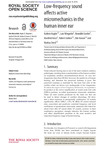Please use this identifier to cite or link to this item:
http://lib.hpu.edu.vn/handle/123456789/21695Full metadata record
| DC Field | Value | Language |
|---|---|---|
| dc.contributor.author | Kugler, Kathrin | en_US |
| dc.contributor.author | Wiegrebe, Lutz | en_US |
| dc.contributor.author | Grothe, Benedikt | en_US |
| dc.date.accessioned | 2016-06-25T01:57:06Z | |
| dc.date.available | 2016-06-25T01:57:06Z | |
| dc.date.issued | 2014 | en_US |
| dc.identifier.other | HPU4160197 | en_US |
| dc.identifier.uri | https://lib.hpu.edu.vn/handle/123456789/21695 | - |
| dc.description.abstract | Noise-induced hearing loss is one of the most common auditory pathologies, resulting from overstimulation of the human cochlea, an exquisitely sensitive micromechanical device. At very low frequencies (less than 250 Hz), however, the sensitivity of human hearing, and therefore the perceived loudness is poor. The perceived loudness is mediated by the inner hair cells of the cochlea which are driven very inadequately at low frequencies. | en_US |
| dc.format.extent | 11 p. | en_US |
| dc.format.mimetype | application/pdf | - |
| dc.language.iso | en | en_US |
| dc.publisher | The Royal Society | en_US |
| dc.subject | Biophysics | en_US |
| dc.subject | Neuroscience | en_US |
| dc.subject | Physiology | en_US |
| dc.subject | Cochlea | en_US |
| dc.subject | Low-frequency sound | en_US |
| dc.subject | Spontaneous | en_US |
| dc.subject | Otoacoustic emissions | en_US |
| dc.subject | Noise-induced | en_US |
| dc.subject | Hearing loss | en_US |
| dc.title | Low-frequency sound affects active micromechanics in the human inner ear | en_US |
| dc.type | Book | en_US |
| dc.size | 617KB | en_US |
| dc.department | Education | en_US |
| Appears in Collections: | Education | |
Files in This Item:
| File | Description | Size | Format | |
|---|---|---|---|---|
| 0080_Lowfrequencysoundaffectsactivemicromechanics.pdf Restricted Access | 617.13 kB | Adobe PDF |  View/Open Request a copy |
Items in DSpace are protected by copyright, with all rights reserved, unless otherwise indicated.
